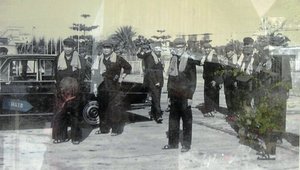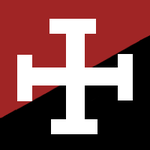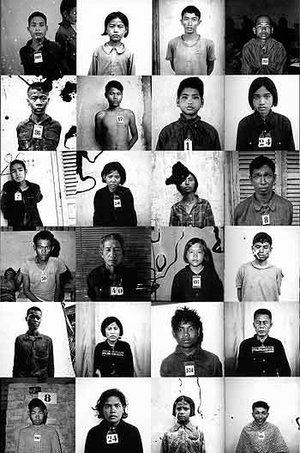Khmer Rouge
|
|
The Khmer Rouge (Khmer: Missing image
KhRouge.png
, pronounced Khmaey Krahom or ; French: Khmer Rouge in the masculine singular, Khmers Rouges in the plural) was a Communist organization which ruled Cambodia from 1975 to 1979. The term Khmer Rouge, which means "Red Khmer" in French, was coined by the francophone king and later prime minister of Cambodia Norodom Sihanouk, and adopted in English. The official name of the Khmer Rouge was the Communist Party of Cambodia, later the Party of Democratic Kampuchea. It was also known as the Communist Party of Kampuchea, the Khmer Communist Party and the National Army of Democratic Kampuchea.
The Khmer Rouge regime is remembered mainly for the deaths of an estimated 1.7 million people, through execution, starvation and forced labor. In terms of the number of people killed as a proportion of the population of the country it ruled, it was one of the most violent regimes of the 20th century, and is often compared with the regimes of Adolf Hitler, Joseph Stalin, and Mao Zedong. Nevertheless, only three of the Khmer Rouge leaders have been imprisoned since their rule ended, one on unrelated charges.
| Contents |
Establishment

The Indochinese Communist Party was founded in 1931, and a separate Cambodian Communist Party was founded in 1951, although later the Khmer Rouge leader, Pol Pot, insisted that the party was founded in 1960. In its early years the party remained subordinate to the Communist Party of Vietnam. From the mid 1960s the Cambodian Communists conducted a low-level insurgency along the Vietnamese border, mainly in support of the Vietnamese Communists in their war with the United States.
In the 1970s the Party became known as the Communist Party of Kampuchea (CPK) and in the 1980s and 1990s as the Party of Democratic Kampuchea, but it became commonly known by the French name Khmer Rouge, a name originally given by Norodom Sihanouk in the 1950s.
The Standing Committee of the Khmer Rouge's Central Committee ("Party Center") during its period of power consisted of:
- Pol Pot (Saloth Sar) "Brother number 1" the effective leader of the movement, General secretary since February 1963 (dead, March 15, 1998)
- Nuon Chea "Brother number 2" Prime Minister (alive)
- Ieng Sary "Brother number 3" Deputy Prime Minister (Pol Pot's brother-in-law) (alive)
- Khieu Samphan President of the Khmer Rouge (alive)
- Ta Mok (Chhit Chhoeun) "Brother number 7" Final Khmer Rouge leader, Southwest Regional Secretary (alive)
- Son Sen Defense Minister (dead), also;
- Yun Yat (dead), Ke Pauk "Brother number 13" Former secretary of the Nothern zone (dead) and Ieng Thirith (alive).
The leadership of the Khmer Rouge was largely unchanged between the 1960s and the mid-1990s. The Khmer Rouge leaders were mostly from middle-class families and had been educated at French universities. The great majority of Khmer Rouge fighters were from poor peasant families and many were conscripted. The Khmer Rouge was funded by Vietnam in the 1950s, supplied with small arms, explosives, military weapons and support from China in the 1980s and had approximately 8,000 guerillas.
Political ideology
The ideology of the Khmer Rouge combined an extreme, somewhat revised form of Maoism with the anti-colonialist ideas of the European Left, which its leaders had acquired during their education in French universities in the 1950s. To this was added resentment against the Cambodian Communists' long subordination to the Vietnamese.
In power, the Khmer Rouge carried out a radical program that included isolating the country from foreign influence, closing schools, hospitals and factories, abolishing banking, finance and currency, outlawing all religions, confiscating all private property and relocating people from urban areas to collective farms where forced labor was widespread. The purpose of this policy was to turn Cambodians into "new people" (Khmer: monou thmey) through agricultural labour. It resulted in massive deaths through executions, work exhaustion, and starvation.
The Khmer Rouge's defenders have justified such actions by claiming that the country was on the verge of mass starvation as a result of U.S. bombing campaigns (killing an estimated 600,000), and that it was impossible to transport sufficient food to feed an urban population of between 2 and 3 million people. This required evacuating the cities to the countryside so that people could become self-sufficient. In fact the motive for the policy was primarily ideological. Furthermore, given that we do not know if the country was in such dire straits - but we do know that the Khmer Rouge's "solution" was an unmitigated human disaster - such revisionism is somewhat hollow.
Rise of the Khmer Rouge
Kr3.JPG
In 1970 Cambodia's neutralist ruler, Prince Norodom Sihanouk, was deposed while out of the country by a coup d'état, widely believed to have been organized by the United States, which brought General Lon Nol to power. Sihanouk formed a government in exile, the Royal Government of National Union of Kampuchea (GRUNK) which was run by the National United Front of Kampuchea (FUNK), and whose armed forces were the Cambodian People's National Liberation Armed Forces. These bodies included some neutralist and other non-Communist politicians, but they were generally seen to be fronts for the Khmer Rouge, and when they came to power it was the Communists of the Khmer Rouge who controlled the regime.
With American financial support, Lon Nol attempted to fight the Vietnamese Communists and the Khmer Rouge. American bombing in Cambodia and the subsequent Cambodian casualties made Lon Nol's government unpopular, and caused support for the Khmer Rouge to grow, particularly in the countryside. Support for Sihanouk, in exile in Beijing, was strong in rural areas, and he urged resistance against Lon Nol's regime.
By 1973 the Khmer Rouge exercised de facto control over the majority of Cambodian territory, although only a minority of its population. On April 17 1975 they captured Phnom Penh.
The Khmer Rouge soldiers told residents that they would be moved only about "two or three kilometers" outside the city and would return in "two or three days." Some witnesses say they were told that the evacuation was because of the "threat of American bombing" and that they did not have to lock their houses since the Khmer Rouge would "take care of everything" until they returned.
The Khmer Rouge in power
The Khmer Rouge attempted to turn Cambodia into a classless society by depopulating cities and forcing the urban population into agricultural communes. The entire population was forced to become farmers in labour camps. During their four years in power, the Khmer Rouge overworked and starved the population, at the same time executing selected groups (including intellectuals) and killing many others for even minor breaches of rules.
Cambodians were expected to produce three tons of rice per hectare; before the Khmer Rouge era the average was one ton per hectare. The Khmer Rouge forced people to work for 12 hours non-stop, without adequate rest or food. They did not believe in western medicine but instead favoured traditional peasant medicine; many died as a result. Family relationships were also banned, and family members could be put to death for communicating with each other.
The Khmer language has a complex system of usages to define speakers' rank and social status. During the rule of the Khmer Rouge, these usages were abandoned. People were however, encouraged to call each other "friend," or "comrade" (Khmer: "miet"), and to avoid traditional signs of deference such as bowing or folding the hands in salutation. Language was transformed in other ways. The Khmer Rouge invented new terms. People were told they must "forge" (Khmer: "lot dam") a new revolutionary character, that they were the "instruments" (Khmer: "opokar") of the Angkar (Organization, not to be confused with Angkor), and that nostalgia for prerevolutionary times (Khmer: "choeu stek arom", or "memory sickness") could result in their receiving Angkar's "invitation."
Killings and torture
The Khmer Rouge regime arrested, tortured and eventually executed anyone suspected of connections with the former government or with foreign governments, professionals, intellectuals as well as ordinary Khmer people who breached their rules. Ethnic Vietnamese, Cambodian Christians, Muslims and the Buddhist monkhood were also targets of persecution. Since China was the Khmer Rouge regime's only diplomatic ally, the Chinese community was not molested, but many Chinese left the country because of the suppression of private business.
Examples of the killings and torture by the Khmer Rouge can be seen at S-21 (now Tuol Sleng Museum), operated by "Duch" (Khang Khek Leu), a high school turned prison camp. Some 200,000 people passed through this centre before taken to sites outside Phnom Penh such as Choeung Ek, where most were executed and buried in mass graves.
The exact number of people who died as a result of the Khmer Rouge's policies is debated. The Vietnamese-installed regime that succeeded the Khmer Rouge claimed that 3.3 million had died. The CIA estimated that between 50,000 and 100,000 people were executed by the Khmer Rouge, but executions represented only a minority of the death toll, which mostly came from starvation.
The United States Department of State and the State Department funded Yale Cambodian Genocide Project give estimates of the total death toll as 1.2 million and 1.7 million respectively. Amnesty International gives estimates of the total death toll as 1.4 million. R. J. Rummel, an analyst of historical political killings, gives a figure of 2 million. Former Khmer Rouge leader Pol Pot gave a figure of 800,000. An Italian Catholic magazine claimed to have had an interview with Khieu Samphan where he said 1 million had died, although that he ever made the statement is disputed.
In 1962, the last census before Cambodia was engulfed by war, the population of the country was 5.7 million. A decade later, in 1972, the population was estimated at 7.1 million. Using Amnesty International's figure of 1.4 million deaths, about 20 percent of the population would have died between 1975 and 1978.
Fall of the Khmer Rouge
In December 1978, after several years of border conflict and a flood of refugees into Vietnam, Vietnamese troops invaded Cambodia, capturing Phnom Penh on January 7, 1979 and deposing the Khmer Rouge regime. Despite Cambodians' traditional fear of Vietnamese domination, the Vietnamese invaders were assisted by widespread defections of Khmer Rouge activists, who formed the core of the post-Khmer Rouge government. The Khmer Rouge retreated to the west and continued to control an area near the Thai border for the next decade, unofficially protected by elements of the Thai Army and funded by smuggled diamonds and timber. In 1985 Khieu Samphan officially succeeded Pol Pot as head of the Khmer Rouge.
The U.S. and other western governments, along with China, continued to recognise "Democratic Kampuchea" as the legitimate government of Cambodia, in order to signal their disapproval of the Vietnamese occupation of the country, which was backed by the Soviet Union. China launched a punitive invasion of northern Vietnam. The U.S. channelled some support to the Khmer Rouge resistance in western Cambodia via surrogates in Thailand, while the Thai military provided them with intelligence. While eastern and central Cambodia were firmly under the control of Vietnam and its Cambodian allies by 1980, the western part of the country continued to be a battlefield through the 1980s, with millions of landmines sown across the countryside.
After a decade of inconclusive conflict, all Cambodian political factions signed a treaty in 1991 calling for elections and disarmament. But in 1992 the Khmer Rouge resumed fighting and the following year they rejected the results of the elections. There was a mass defection in 1996 when around half the remaining soldiers (about 4,000) left. Factional fighting in 1997 led to Pol Pot's trial and imprisonment by the Khmer Rouge itself. Pol Pot died in April 1998, and Khieu Samphan surrendered in December. On December 29, 1998 the remaining leaders of the Khmer Rouge apologised for the deaths in the 1970s. By 1999 most members had surrendered, or been captured. In December 1999 Ta Mok and the remaining leaders surrendered and the Khmer Rouge effectively ceased to exist.
Before the Khmer Rouge came to power some Cambodians had already fled to refugee camps. But those who were not able to flee had to work in rural farms until the Vietnamese had liberated them and later escaped to the camps. Many Cambodians had crossed the border into Thailand to seek asylum. From there they were transported to refugee camps such as Khao-I-Dang, the only camp allowing resettlement in countries such as the United States, France, Canada, and Australia.
Recovery and trials
Since 1990 Cambodia has gradually recovered, demographically and economically, from the Khmer Rouge regime, although the psychological scars affect many Cambodian families and emigre communities. Although the current government teaches about Khmer Rouge atrocities in the schools, Cambodia has a very young population and by 2005 three-quarters of Cambodians were too young (less than 20 years old) to remember the Khmer Rouge years. The younger generations would only know the Khmer Rouge through word-of-mouth from parents and elders.
When the Vietnamese defeated the Khmer Rouge, Duch attempted to destroy the documents at Tuol Sleng. However, he left over 100,000 pages of documentation of Tuol Sleng. Another 100,000 pages of documents were left behind at Son Sen's (presumed) residence. Most of the remaining Khmer Rouge leaders live in the Pailin area or are hidden in Phnom Penh.
In 1997, Cambodia established a Khmer Rouge Trial Task Force (http://www.cambodia.gov.kh/krt/english/) consisting of 300 people, to create a legal and judicial structure to try the remaining leaders for war crimes, genocide, and crimes against humanity. However, a shortage of funds has halted the operation. As of March 2005, international funding through the Group of Interested States and United Nations logistical support have been promised to support any trials. With US $43 million required for a trial, Japan is the largest donor at $21.6 million. The United States has yet to provide financial support due to complications with the Foreign Operations Appropriations Act of 2005, which disallowed funding a Cambodian tribunal. The tribunal will be held at military barracks near Phnom Penh due to security concerns.
Critics, however, continue to doubt that any of the Khmer Rouge leaders will be brought to justice. Some observers attributed the slow progress to the presence of former Khmer Rouge members in the current government, and fears of renewed violence by Khmer Rouge supporters.
References
- Country Studies: Cambodia (http://countrystudies.us/cambodia/) (Public Domain text) Accessed 8 February 2005
- KR Years: The faces of Angka (http://www.edwebproject.org/sideshow/khmeryears/angka.html) Accessed 5 February 2005
- KR Year: The fall (http://www.edwebproject.org/sideshow/khmeryears/fall.html) Accessed 8 February 2005
- Yale University: Cambodian Genocide Program (http://www.yale.edu/cgp/kr.html) Accessed 5 February 2005
- Asia Times Online: "Rouge Justice" (http://www.atimes.com/atimes/Southeast_Asia/GD14Ae03.html) Accessed 16 April 2005
- Thai/Cambodia Border Refugee Camps 1975-1999 (http://www.websitesrcg.com/border/index.html) Accessed 16 April 2005
- Harvard University (http://www.fas.harvard.edu/~asiactr/haq/200001/0001a009.htm) Accessed 9 February 2005
- Infoplease: Khmer Rouge (http://www.infoplease.com/spot/khmer2.html) Accessed 5 February 2005
- HistoryNet: Losing Ground to Khmer Rouge (http://www.thehistorynet.com/vn/blkhmer_rouge/index2.html) Accessed 6 February 2005
- Documentation Center of Cambodia (http://www.dccam.org/) Accessed 6 February 2005
- Mekong: The Khmer Ruge in Cambodia (http://www.mekong.net/cambodia/uniq_rev.htm) Accessed 7 February 2005
- MIPT Terrorism Knowledge Base (http://www.tkb.org/Group.jsp?groupID=4099) Accessed 8 February 2005
- Party of Democratic Kampuchea (http://members.tripod.com/~fantasian/pdk.html) Accessed 8 February 2005
- MSN Encarta (http://encarta.msn.com/encyclopedia_761570298_9____28/Cambodia.html)
Further reading
Two of the very few western scholars who know the Khmer language and have published works about Cambodia are Ben Kiernan and David P. Chandler.
- David P. Chandler: A History of Cambodia (Westview Press 2000); ISBN 0813335116.
- David P. Chandler: Brother Number One: A Political Biography (Westview Press 1999); ISBN 813335108.
- David P. Chandler: Facing the Cambodian past: Selected essays, 1971-1994 (Silkworm Books 1996); ISBN 9747047748.
- David P. Chandler, Ben Kiernan etc.: Revolution and Its Aftermath in Kampuchea: Eight Essays (Yale University Press 1983); ISBN 0938692054.
- Ben Kiernan: The Pol Pot Regime: Race, Power, and Genocide in Cambodia under the Khmer Rouge, 1975-79; ISBN 0300096496.
- Ben Kiernan: How Pol Pot Came to Power: Colonialism, Nationalism, and Communism in Cambodia, 1930-1975 (Yale University Press, Second Edition 2004); ISBN 0300102623.
See also
External links
- Yale University: Cambodian Genocide Program (http://www.yale.edu/cgp/)
- "The Demography of Genocide: Cambodia and East Timor" (http://www.yale.edu/gsp/publications/KiernanRevised1.pdf) (Critical Asian Studies, 35:4, 2003) [in .pdf format]
- Digital Archive of Cambodian Holocaust Survivors (http://www.cybercambodia.com/dachs/)
- The Khmer Rouge Canon 1975-1979: The Standard Total Academic View on Cambodia (http://jim.com/canon.htm)
- PBS Frontline/World: Pol Pot's Shadow (http://www.pbs.org/frontlineworld/stories/cambodia/index.html)
- Calculations for Cambodian genocide figures (http://www.hawaii.edu/powerkills/SOD.CHAP4.HTM)
- Cambodia Tales: Khmer Rouge torture and killing paintings (http://www.btinternet.com/~andy.brouwer/vannnath.htm)
- Averaging Wrong Answers: Noam Chomsky and the Cambodia Controversy (http://www.mekong.net/cambodia/chomsky.htm)
- Meet the Press: Transcript for Jan. 30 Guests: Sen. John Kerry, D-Mass (http://www.msnbc.msn.com/id/6886726/)
- "Privatizing a Mass Grave in Cambodia" (http://montages.blogspot.com/2005/04/privatizing-mass-grave-in-cambodia.html)
- Democratic Kampuchea (it's a Yahoo Goup for the ideological reclamation of Pol Pot) (http://groups.yahoo.com/group/DemocraticKampuchea/)de:Rote Khmer
es:Jemeres Rojos fr:Khmers rouges id:Khmer Merah he:חמר רוז' nl:Rode Khmer ja:クメール・ルージュ pl:Czerwoni Khmerzy fi:Punaiset khmerit sv:Röda khmererna zh:柬埔寨共產黨


